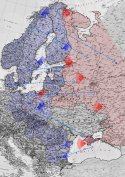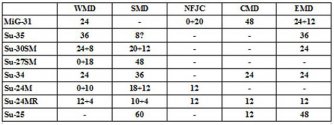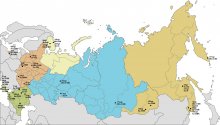A few months ago I made a quick map to study the change of strategic and operational context for Russia after Sweden and Finland join NATO.
2400 x 3400 pixels - zoom in.
View attachment 91931
Distances are indicative. The arrows are either 600km mission range for F-16 or 1200km mission range for F-35. The fan-like colored areas are indicative missile ranges with maximum, effective and no escape ranges given for AIM-120C7 (applicable for Meteor) and a theoretical Russian equivalent.
Circles denote theoretical maximum (public data) range for specific missile type for Patriot and S-400. Location does not reflect actual placement of systems in wartime. They illustrate distances in important areas where air defense units are permanently stationed.
Blue and Red dots are main air force bases in the theater.
Current approximate air forces in the Western and Northern Military Districts (here: WMD and NFJC) - first figure is air force, second figure is naval aviation.
View attachment 91932
This is a map of fighter units in Russia (minor errors in Eastern district):
View attachment 91933
MiG-31 is effectively useless in traditional air-to-air combat. It is an interceptor designed for countering bombers and cruise missiles. In theory it could attack AWACS and tanker aircraft but it is too outdated, despite a (failed) modernization for that purpose to perform it effectively. This leaves Russia with limited numbers of Su-35S and Su-30SM.
Furthermore considering Western and Northern military districts the long term shift in capabilities is staggering:
- Finland ordered 64 F-35 and will receive them from 2026 to 2030. Currently they have ~60 F-18C/D.
- Norway ordered 52 F-35 and should receive them by 2026.
- Denmark ordered 27 F-35 and should receive them by 2026.
- Poland ordered 32 F-35 and should receive them by 2030, and will retain at least 32 F-16c into the 2030s.
- Sweden ordered 60 JAS39E/F but will likely retain also 20 additional JAS39C/D into the 2030s. Currently they have ~90 JAS39C/D
By 2030 five
traditionally anti-Russian countries will have 175 F-35s and 90-120 4gen fighters.
By this time Russia planned to have ~80 Su-57s but those plans might not be feasible considering economic situation and sanctions. It is very likely that the production will be further delayed and possibly quite significantly.
In early 2030s the balance will likely be: 175 F-35 + 90-120 JAS39/F-16 vs ~72 Su-35S/30SM + 36 (planned) Su-57
without including US/UK assets or other NATO assets. Su-34s and bombers do not enter the picture as they are not capable enough to defend against enemy air superiority missions meaning that
Russia will not be able to use them in their intended role due to enemy numerical superiority.
Furthermore by including Sweden's and Finland's airspace as part of NATO airspace it allows for vectors of attack which were until now impossible - as indicated on the first map. Finland's border with Russia allows deep penetrating strikes on Moscow region and Northern Fleet facilities that won't be protected sufficiently well by air defense assets because the infrastructure and air defenses in the region haven't been upgraded since 1991.
If we include the change of security in the maritime domain the Baltic Sea becomes a "NATO lake" - with two easily isolated weak naval facilities in St Petersburg (Kronshtad) and Kaliningrad (Baltiysk) serving a weak naval force. Baltic Fleet currently consists of:
- 1 (old) destroyer (Sovremenny) serving as a flag/command ship
- 2 (old) frigates (Neustrashimy) serving as ASW vessels
- 4 (new) corvettes (Steregushchiy) serving as ASW/AAW vessels
- 6 (old) corvettes (Parchim) serving as ASW vessels
- 4 (new) corvettes (Karakurt) serving as missile boats
- 3 (old) corvettes (Nanuchka) serving as missile boats
- 2 (new) missile boats (Buyan-M)
- 6 (old) missile boats (Tarantul)
additionally Baltic Fleet maintains 1 (old) submarine (Kilo) for training purposes.
In the coming decade - assuming current orders are maintained - BF will likely have a total of:
- 3 Improved Kilo submarines,
- 6 Steregushchiy corevettes,
- 6 Karakurt corvettes/missile boats,
- 3 Buyan-M missile boats
- 1-2 older larger ships 1 retained in service.
Such composition will result in a force marginally more capable than the
current Black Sea Fleet.
Improved Kilo is an obsolete design, without AIP which makes it extremely vulnerable in Baltic shallows.
Stereguschiy is a moderately capable corvette that lacks proper air defenses.
Karakurt and Buyan-M are missile boats made to look dangerous by Russian and American propaganda.
The convenient strategic "resource sink" that used to be Lithuania, Latvia and Estonia - that is an area that forced NATO to expend resources for non-viable defense while Russia could threaten by staying on the defensive within their own territory - has been replaced by a viable first line of defense backed by full NATO control of sea and airspace. Nothing short of a massed push against the Baltics, impossible now due to the invasion of Ukraine, can achieve any degree of success.
NATO expansion will also have consequences in the Southern Military District i.e. Black Sea region which is currently weakest of the three "main" military districts, with Central and Northern being of secondary rank compared to Western, Southern and Eastern. While NATO forces (excluding Turkey) remain weak Russian air force in the region is also weak and it is likely that some assets will have to be moved to secure the north.
Considering:
- vulnerable geographical position of Ukraine
- vulnerable geographical position of Baltic states
- placement of strategic facilities in European Russia
it would be better for Russia to allow for some delayed entry of Ukraine into NATO than have Sweden and Finland as part of the alliance under the current conditions. This was the equivalent of trading a pawn for a queen without clear gains in a game of traditional (a.k.a 2d) chess.
In historical terms Russia just lost all the gains of the Great Northern War (1700-1721) fought by Peter I which made it an European power. Putin wanted to be like Peter I and instead he lost everything that Peter I gained. Interestingly the most important battle of the war took place in Ukraine - near Poltava in 1709 - where Sweden was weakened strategically in much the same way that Russia is being weakened right now. The war went on for over a decade afterward but the crucial battle that decided the long-term outcome took place in 1709.
This whole thing feels like something out of a Hollywood movie script. History indeed is where the best stories can be found.




